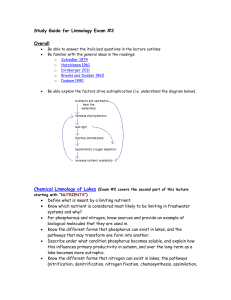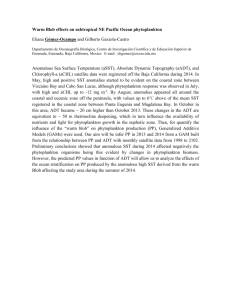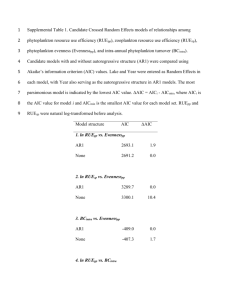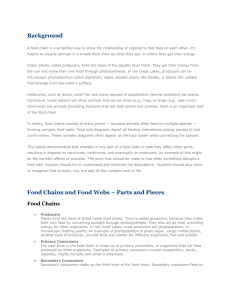Review of:
advertisement
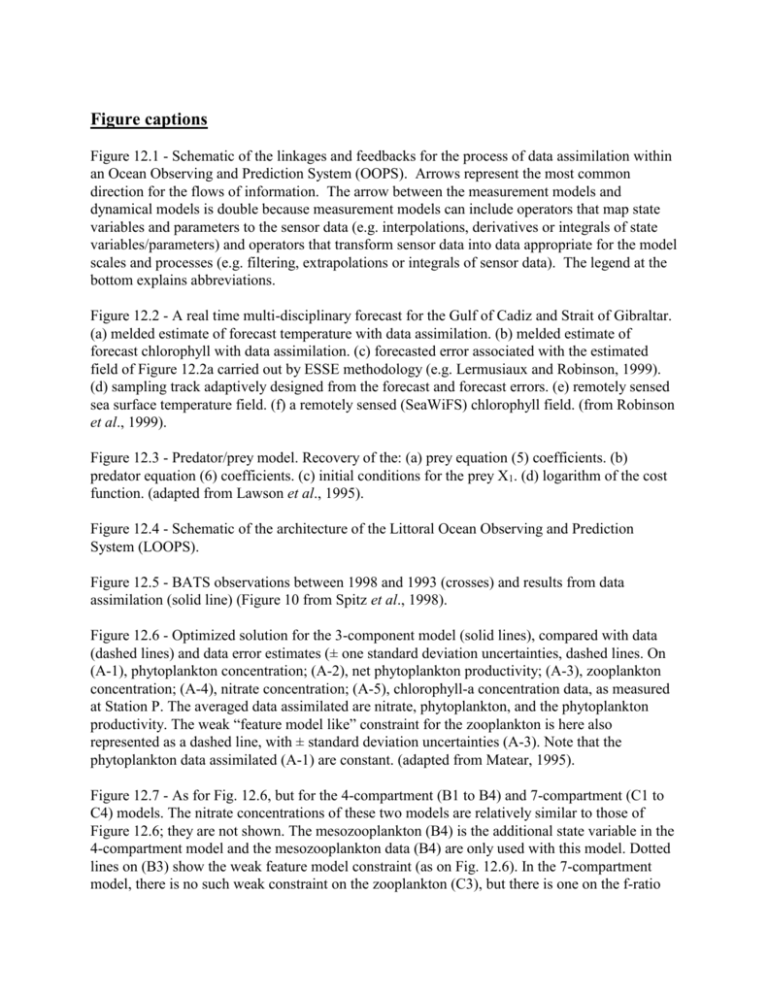
Figure captions Figure 12.1 - Schematic of the linkages and feedbacks for the process of data assimilation within an Ocean Observing and Prediction System (OOPS). Arrows represent the most common direction for the flows of information. The arrow between the measurement models and dynamical models is double because measurement models can include operators that map state variables and parameters to the sensor data (e.g. interpolations, derivatives or integrals of state variables/parameters) and operators that transform sensor data into data appropriate for the model scales and processes (e.g. filtering, extrapolations or integrals of sensor data). The legend at the bottom explains abbreviations. Figure 12.2 - A real time multi-disciplinary forecast for the Gulf of Cadiz and Strait of Gibraltar. (a) melded estimate of forecast temperature with data assimilation. (b) melded estimate of forecast chlorophyll with data assimilation. (c) forecasted error associated with the estimated field of Figure 12.2a carried out by ESSE methodology (e.g. Lermusiaux and Robinson, 1999). (d) sampling track adaptively designed from the forecast and forecast errors. (e) remotely sensed sea surface temperature field. (f) a remotely sensed (SeaWiFS) chlorophyll field. (from Robinson et al., 1999). Figure 12.3 - Predator/prey model. Recovery of the: (a) prey equation (5) coefficients. (b) predator equation (6) coefficients. (c) initial conditions for the prey X1. (d) logarithm of the cost function. (adapted from Lawson et al., 1995). Figure 12.4 - Schematic of the architecture of the Littoral Ocean Observing and Prediction System (LOOPS). Figure 12.5 - BATS observations between 1998 and 1993 (crosses) and results from data assimilation (solid line) (Figure 10 from Spitz et al., 1998). Figure 12.6 - Optimized solution for the 3-component model (solid lines), compared with data (dashed lines) and data error estimates (± one standard deviation uncertainties, dashed lines. On (A-1), phytoplankton concentration; (A-2), net phytoplankton productivity; (A-3), zooplankton concentration; (A-4), nitrate concentration; (A-5), chlorophyll-a concentration data, as measured at Station P. The averaged data assimilated are nitrate, phytoplankton, and the phytoplankton productivity. The weak “feature model like” constraint for the zooplankton is here also represented as a dashed line, with ± standard deviation uncertainties (A-3). Note that the phytoplankton data assimilated (A-1) are constant. (adapted from Matear, 1995). Figure 12.7 - As for Fig. 12.6, but for the 4-compartment (B1 to B4) and 7-compartment (C1 to C4) models. The nitrate concentrations of these two models are relatively similar to those of Figure 12.6; they are not shown. The mesozooplankton (B4) is the additional state variable in the 4-compartment model and the mesozooplankton data (B4) are only used with this model. Dotted lines on (B3) show the weak feature model constraint (as on Fig. 12.6). In the 7-compartment model, there is no such weak constraint on the zooplankton (C3), but there is one on the f-ratio (not shown). The bacteria concentration (C-4) illustrates the microbial loop. (adapted from Matear, 1995). Figure 12.8 - Optimized, scaled (0 to 1) parameter values associated with each of the minima located by the twelve optimization routines (abbreviated routine names and their symbols are on top of the figure). Model parameters (left ordinate) and their absolute parameter bounds (right ordinate) are described in Vallino (2000). Parameters marked with an asterisk (left ordinate) were held constant during the data assimilation. (from Vallino, 2000). Figure 12.9. - Schematic of the biological components (phytoplankton (P), zooplankton (Z), ammonium (A), nitrate (N) and detritus (D)) and biological interactions included in the equatorial Pacific ecosystem model. (Figure adapted from Friedrichs and Hofmann (2001).) Figure 12.10 - Fourteen-day averaged time evolution (beginning on 9/1/91) of fifty forward model simulations, generated using fifty randomly selected sets of parameter values that fall within the reasonable ranges discussed in text: (a) primary production, (b) phytoplankton, (c) zooplankton, (d) ammonium and (e) nitrate. Average values from the TS1 (square) and TS2 (triangle) cruise data are shown for comparison. All quantities are depth-averaged over the euphotic zone. (Figure from Friedrichs (2001).) Figure 12.11 - Simulated time distributions of (a) primary production, (b) phytoplankton, (c) zooplankton, (d) ammonium and (e) nitrate obtained using two optimal parameter sets recovered from the assimilation of the TS1 data set (parameter set A; solid line) and a subset of the TS2 data set (parameter set B; dotted line) using the adjoint method. The TS1 data (filled squares), TS2 data (open squares) and the subset of the TS2 data (filled triangles) are shown for comparison. (Figure adapted from Friedrichs (2001).) Figure 12.12 - Schematic of the bottom topography of the Gulf of Maine and Georges Bank. NEP: Northeast Peak; SF: Southern Flank (Figure 1 from Lynch et al., 1998). Figure 12.13 - Biological/physical simulations of Calanus finmarchicus population dyanmics. (a) vertical averaged Lagrangian velocity for Jan-Feb. (b) average surface layer (top 25m) Lagrangian velocity for Jan-Feb. (c) decadally averaged bimonthly adult Calanus abundances in the upper 200m centered on Jan. 1. (d) decadally averaged bimonthly adult Calanus abundances in the upper 200m centered on Mar. 1. (e) adult Calanus abundances on Mar. 1from G0 simulation. (f) adult Calanus abundances on Mar. 1from G1 simulation. (from Lynch et al, 1998). Figure 12.14 - Schematic of final G1 initiation scenario. (a) Large source population of diapausing animals in the deep basins of the Gulf of Maine. (b) Slow bankward transport of rising C5s. (c) Fast bankward transport of adults in the surface layer. (d) Reproduction on the bank where food is abundant. (e) Loss from bank. (Figure 23 from Lynch et al., 1998). Figure 12.15 - Top row: bimonthly climatological Pseudocalanus spp. distributions (adults only) objectively analyzed from the MARMAP data (number of animals m–3). Second row: three source terms B(x, y) resulting from three of the six inversions. Each B(x, y) is located directly below the analyzed data used to initialize the experiment. That is, the JF–MA source term results in a forward model integration which matches the March–April analyzed data. Last two rows: two of the remaining terms in the ADR equation, adjective flux divergence and overall tendency, averaged over the period of integration. Fields in the bottom three rows have been normalized to the bottom depth, so the units are “number of animals m–4s–1.” (from McGillicuddy et al., 1998). Figure 12.16 - Five-component biological model. The five state variables are nitrate (N), phytoplankton (P), zooplankton (Z), ammonium (A) and dissolved and suspended particulate organic nitrogen (D). Fast-sinking detritus (P) is included but sinks and remineralizes instantaneously, and thus is not an explicit state variable. (Figure 3 from Anderson et al., 2000). Figure 12.17 - (a) Flowchart for creating compatible physical and biological initialization and assimilation fields. (b) Time chart of compatible physical and biological field generation and assimilation into the main simulation. (Figures 1 and 2 from Anderson et al., 2000). Figure 12.18 - Comparison of model simulation using assimilation of physical and biological fields versus assimilation of physical fields only. (a) temperature at day 7 - physics and biology. (b) temperature at day 10 - physics and biology. (c) phytoplankton at day 7 - physics and biology. (d) phytoplankton at day 10 - physics and biology. (e) phytoplankton at day 7 - physics only. (f) phytoplankton at day 10 - physics only. Figure 12.19 - (a) Harvard Ocean Prediction System (HOPS) schematic. (b) schematic of the Biogeochemical/Ecosystem Model component of HOPS. Figure 12.20 - Locations of various one and two way nested forecast domains. Figure 12.21 - Massachusetts Bay. (a) schematic of circulation features and dominant variabilities. The lines with divergent arrowheads indicate that the direction of circulations is variable. Dotted lines indicate that the location of features varies. (b) forecast of the standard error deviation for the surface temperature, with tracks for adaptive sampling. (c) chlorophyll-a at 10 m, with overlying velocity vectors. (d) vertical section of zooplankton along the entrance of Massachusetts Bay. Figure 12.22 - Example Real-Time Demonstration of Concept (RTDOC-98) products for April 28, 2000. (a) 15m temperature. (b) 15m chlorophyll-a. (c) idealized bottom cod abundance forecast, based on an exemplary rather than realistic model.


